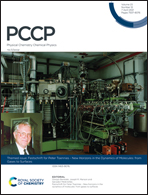Normal and off-normal incidence dissociative dynamics of O2(v,J) on ultrathin Cu films grown on Ru(0001)
Abstract
The dissociative adsorption of molecular oxygen on metal surfaces has long been controversial, mostly due to the spin-triplet nature of its ground state, to possible non-adiabatic effects, such as an abrupt charge transfer from the metal to the molecule, or even to the role played by the surface electronic state. Here, we have studied the dissociative adsorption of O2 on CuML/Ru(0001) at normal and off-normal incidence, from thermal to super-thermal energies, using quasi-classical dynamics, in the framework of the generalized Langevin oscillator model, and density functional theory based on a multidimensional potential energy surface. Our simulations reveal a rather intriguing behavior of dissociative adsorption probabilities, which exhibit normal energy scaling at incidence energies below the reaction barriers and total energy scaling above, irrespective of the reaction channel, either direct dissociation, trapping dissociation, or molecular adsorption. We directly compare our results with existing scanning tunneling spectroscopy and microscopy measurements. From this comparison, we infer that the observed experimental behavior at thermal energies may be due to ligand and strain effects, as already found for super-thermal incidence energies.

- This article is part of the themed collection: Festschrift for Peter Toennies - New Horizons in the Dynamics of Molecules: from Gases to Surfaces


 Please wait while we load your content...
Please wait while we load your content...